Site drainage project: selection of location, slope, depth, drainage system elements
Low filtration of soils under the soil is the reason for the excess water in the area. It slowly goes into the lower layers or does not leak at all. Here cultivated plants grow poorly or do not take root at all, the territory is swamped, and slush is felt. In such cases, a drainage system is needed, which should be properly organized.
We will explain in detail how to make a site drainage project. Arranged according to our advice, the system will perfectly cope with responsibilities. Familiarization with the proposed information will be useful both to independent owners and landscape arrangement customers in a specialized company.
We presented proven in practice schemes for constructing drainage systems for suburban areas. The article describes in detail the factors requiring consideration in the design and construction of drainage. The information proposed for consideration is illustrated by photographs, diagrams, and videos.
The content of the article:
Garden drainage designation
Reclamation measures, according to the norms (SNiP 2.06.15), are carried out in forest and agricultural lands, so that the soil becomes most suitable for growing fruit trees, grain and vegetable crops.
To do this, form an extensive system of open ditches or closed pipelines, the main purpose of which is to drain excessively wet areas.
The ultimate goal of collecting water through branches and hoses of various types is artificial or natural bodies of water (if conditions permit), special drainage ditches, absorbing wells or storage tanks from which water is pumped out for irrigation and maintenance of the territory.
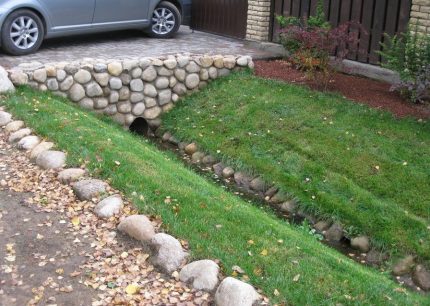
Using the same principle, they construct a network of pipelines for a summer cottage, regardless of its area - 6 or 26 acres. If the area suffers from frequent flooding after rain or spring floods, the construction of catchment facilities is mandatory.
Clay soils contribute to the accumulation of excess moisture: sandy loam and loam, because they do not pass or pass water extremely weakly into the underlying layers.
Another factor that prompts you to think about a drainage project is the increased level of groundwater, the presence of which can be found without special geological exploration surveys.
If on the territory of the summer cottage they dug a pit under a cesspool or septic tank, and it was filled with water, then the aquifers are located in close proximity to the surface of the earth. When arranging a well with a drilling organization, you will receive data on the location of water horizons from specialists.
Even if the foundation stands, there is no guarantee of maintaining a comfortable environment inside the basement floors and basements: dampness, premature corrosion, fungus and mold may occur.
Over time, damp concrete and brick foundations become covered with cracks that are difficult to repair. On the contrary, they continue to grow, provoking movements of buildings. To prevent destruction, even at the stage of building construction, you need to think about the device effective drainage.
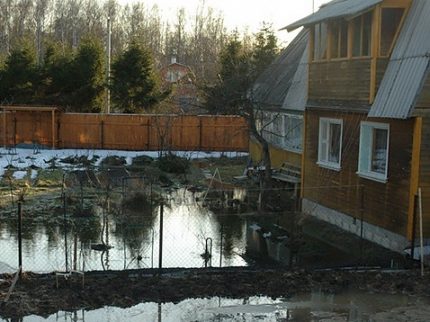
Drainage elements
What is a drainage system? This is a network consisting of various components, the main purpose of which is the removal and collection of capillary water contained in the pores of incoherent soils and cracks of cohesive rocks.
The main underground elements are drainage pipes. They should not be confused with plumbing and sewer, since only water in the upper soil layers moves along them. And storm sewage is involved in collecting and discharging rain and melt water.
More flexible corrugated models are popular. The diameter of the pipes depends on the volume of fluid discharged, standard cross-sectional sizes: 50 mm, 63 mm, 90 mm, 110 mm, 125 mm, 160 mm, 200 mm. For central highways, products of a larger diameter are selected, for branches - a smaller one. Reinforced pipes consist of 2 layers.
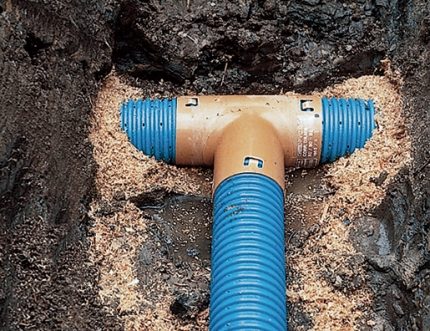
In the joints of several hoses or in areas where the pipes are rotated at a large angle, technical (revision) wells of the same material are installed. These are wide sections of corrugated pipes or specially manufactured factory models.
The drainage system may also include storage wells, which are installed at the lowest points of the site for efficiency. Drives are satisfied if there is no way to discharge the discharged water into a nearby body of water. All drainage lines lead to the wells. They transport water, which is often used for irrigation or household needs.
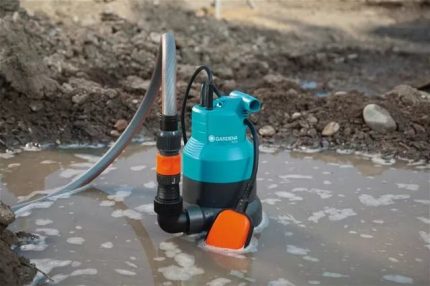
In addition to the basic elements of the system, fittings for connecting pipes, geotextiles and building material for arranging trenches and wells (sand, gravel or crushed stone, concrete rings, bricks) will be required.
Types of water drainage systems from the site
There are many drainage schemes, but all varieties can be combined into three large groups: open, closed and combined. In accordance with this, three main types of drainage structures are distinguished: surface, deep and also combined. Consider the features of each.
Features of open drainage
Water is collected by open drainage thanks to a system of ditches and trenches, that is, objects that are not covered by a layer of earth from above. Arrange it to collect and drain water from the soil-plant layer, i.e. for site drainage. The principle of the open system is based on the ability of groundwater to rush into the space freed from the ground as it flows into the well.
The branched network is located at a small angle so that the water that drains into the grooves flows by gravity outside the boundaries of the site (quarry or fire reservoir) or is accumulated for irrigation in a storage well.
The walls of the grooves of the open system, if necessary, are reinforced with compacted mint clay, laid out with cobblestone or tile. It is permissible to strengthen the interwoven flexible branches of shrubs or suitable trees.
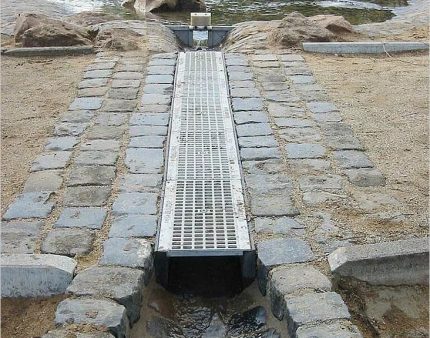
The final point for collecting water from the flooded drainage system is natural (rivers, lakes, ponds) and artificial reservoirs, as well as ditches, ravines, quarries located behind the fences of the summer cottage. The drainage network of the accumulative type involves the collection of transported underground water into the storage well.
System Features:
- coverage of all points of water accumulation;
- calculation of the slope of the drainage trenches;
- Protecting the system from clogging
- measures to prevent the emergence of new wetlands;
- the location of the catchment at the bottom of the terrain.
The norms of the slope of the channels depend on the type of soil: for clayey from 0.002, for sandy - from 0.003.
There is an opinion that open drainage is not aesthetic. This is not so, because many methods have been developed for beautifully designing external drainage systems.
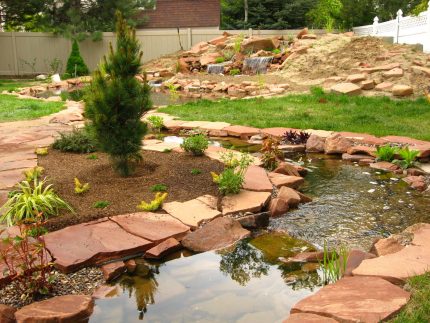
A significant drawback of open drainage lies in a tangible reduction in the usable area of the site. There are restrictions on the depth of the laying of ditches and grooves, as it is not customary to arrange them below 0.5 - 0.7 m from the day surface.
If necessary, to build a drainage system at a greater depth, it is necessary to increase the width of the trenches, arrange transition bridges, carefully think over the drainage scheme so as not to impede the movement of people and personal equipment in the area.
Varieties of Closed Drainage
For the arrangement of closed drainage, an engineering project will be required, since all elements are underground, and the functionality of the system depends on their proper location. Distinguish between local and general view of deep drainage.
If you need to protect the foundation of only one building or divert water from the road - this is a local variety, if you decide to drain the entire site - the general.
Local types of systems, in turn, are divided into:
- wall (in clay soils, on the surface, along the perimeter of buildings - houses, baths, garages);
- reservoir (in the ground under the building);
- ring (in sandy soils, around buildings, below the foundation).
All of these types of closed drainage are used forprevent flooding the foundation, as well as to protect against seepage of groundwater into bulk and basement rooms.
Depending on location drainage pipes systems are divided into various types: horizontal (most popular in the country), vertical and combined.
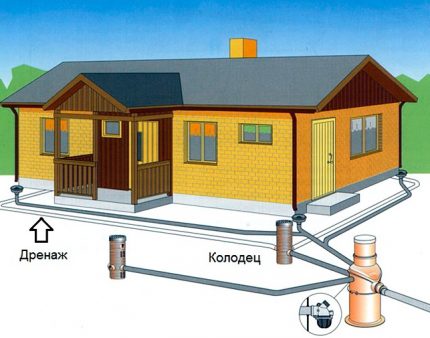
To equip a vertical system using pumping equipment.This is a complex construction, therefore it is extremely rarely used for the improvement of the private sector. Accordingly, the combined type of deep drainage is not common.
Designing a drainage system
To achieve maximum results and create an effective water drainage system, it is necessary to draw up a drainage project. At drawing up a diagram and plan We recommend that you rely on the standards presented in SNiP 2.06.15-85. Here you can also find information on the sizes, quality and material of elements for drainage systems.
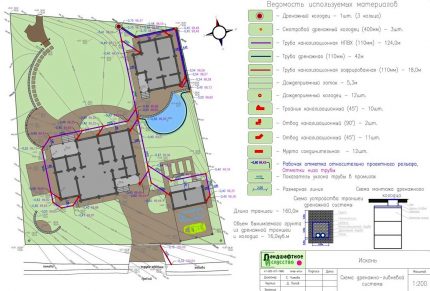
Mandatory application - an estimate indicating construction activities and amounts for materials and work.
Before drafting a project, you must independently or with the help of specialists prepare the following materials:
- data on the soil and upper soil layers (composition, technical characteristics);
- a plan of the location of all significant objects - buildings, a pool, arbors, roads;
- diagrams of the foundations of buildings in different angles and in section, indicating the dimensions and depth of the bookmark;
- topographic map of the cottage plot with indication of the features of the relief;
- scheme of existing surface and underground communications;
- data on the hydrogeological features of the area.
Also on the diagrams and drawings, it is desirable to indicate decorative objects and places of planting of green spaces. This is necessary so that the elements of the drainage system do not damage fruit trees, flower beds, alpine hills, etc.
Designs for sandy and clay soils vary. For example, for sandy ones it is easier to develop a system aimed at lowering the groundwater level, and for loams the most effective is local open drainage.
We remind you that the drainage system only works effectively with a professional approach, amateur schemes often do not work.
Rules and nuances of design
Many factors influence the choice of drainage type for a country house or the location of canals. For example, the terrain is of great importance. If the house is located on a hill, and the rest of the territory is located at a slight slope, then wall drainage is most likely not required, and groundwater can be removed from the site by creating a canal system.
The location of groundwater is important.
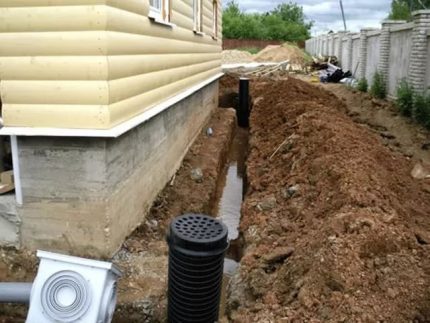
The nature of the surrounding area should also be considered. If the area around the site is swampy or a river flows nearby, and it seems to be dry on a personal plot, then for the purpose of prevention, it is also necessary to design a drainage system.
Consider in more detail the nuances that should also be considered when laying pipelines and trenches.
# 1: Depth and dimensions of the trunk
The location of the pipes of the closed drainage system is selected based on the design development taking into account the bias towards the catchment. The depth of the elements of the system depends on the level of groundwater. For a wall-mounted device, trenches are torn out at the level of the foundation foundation, since its purpose is to strengthen the waterproofing qualities of the underground structure and the protection of the basement.
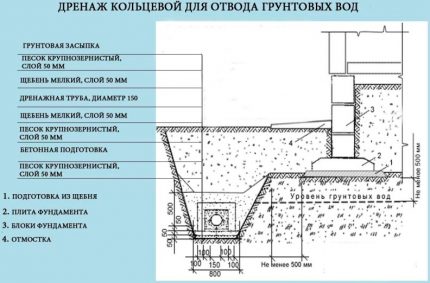
Ring drainage is chosen if the construction of the house has already been completed, respectively, all waterproofing and protective measures have been completed.
If the soil of a garden plot constantly suffers from flooding by atmospheric precipitation or seepage of groundwater, systemic drainage is required throughout the territory. There are many options - from the arrangement of the system around the perimeter to the extensive network, in which all summer cottage facilities (buildings, road surfaces, garden plots) are involved.
The direction of the canals and pipelines is strict - towards the catchment facilities or ditches located outside the territory of the personal plot. This way drainage pipes are laid with a slopenecessary for the free movement of groundwater collected by drains to unloading facilities.
# 2: Slope standards for drainage pipes
Water in horizontally located pipes will stagnate if laid without a slope, the parameters of which are indicated in regulatory documents.
For clay and sandy soil, which has various degrees of water permeability, the norms differ:
- loam and clay - from 0.003 or more;
- sand and sandy loam - from 0.002 and more.
If you translate the values into millimeters, you get 3 mm / linear. meter and 2 mm / linear meter respectively.
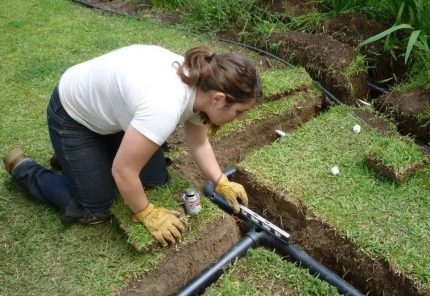
When calculating the maximum possible speed take into account the properties of the surrounding soil, as well as the quality of sprinkling. Do not slope at intervals - it must be observed throughout the pipeline / channel. For hilly terrain, drainage options with differences, with the installation of adapters in the inspection wells, are possible.
Popular drainage schemes
Consider several schemes that are often included in the project drainage at home plot. Among them are systems for draining water from the house, as well as catchment structures of an expanded form.
One of the most common schemes is wall drainage to improve the characteristics of the waterproofing protection of the foundation and basement.
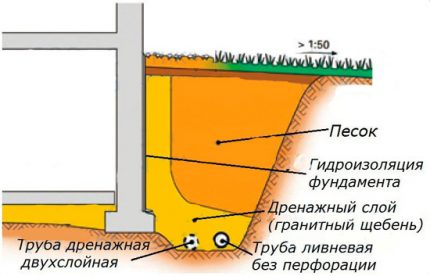
The layout of the storage well for the collection and further use of drainage water is useful to those who are used to economically consume natural resources.
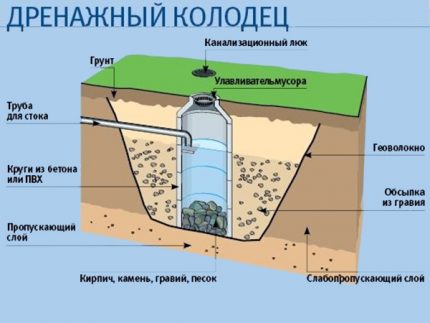
Variant of open drainage scheme. The best option for summer residents who own personal plots with a slope or uneven terrain.

Sketch drainage for landscaping the garden and territory adjacent to the house. Judging by the figure, the house does not need a separately equipped drainage structure.
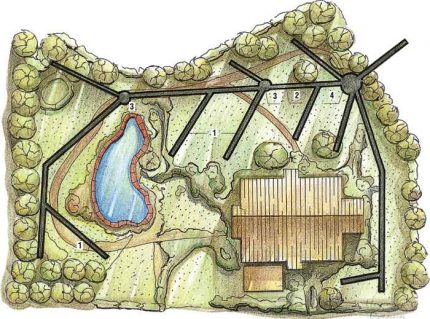
Of course, the choice of the scheme completely depends on the conditions of a particular suburban area, therefore, the design should begin with a study of your own territory.
Conclusions and useful video on the topic
A few useful tips will help to expand knowledge of drainage systems, and may be useful in the construction of structures or trenches with your own hands.
Video # 1. Recommendations for the construction of budget drainage to protect the foundation:
Video # 2. Useful information about different drainage methods:
Video # 3. Tips for choosing drainage pipes:
Designing a drainage system is a responsible occupation that only a specialist can handle. Incorrect pipe laying or errors in the design of engineering structures can cause significant harm.
To protect a house or a plot from groundwater or rainwater, we advise you to contact the design organization. This does not exclude the possibility that you can carry out some landscape improvement activities yourself.
Want to share your own experience in the design or operation of a drainage system? Have questions or useful information on the topic of the article? Please write comments in the block below.

 Drainage device around the house: design and installation of a drainage system with your own hands
Drainage device around the house: design and installation of a drainage system with your own hands 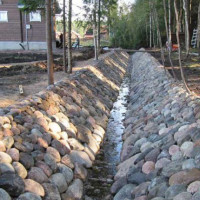 Slope of the drainage pipe: calculations, standards and features of the installation of drainage on the slope
Slope of the drainage pipe: calculations, standards and features of the installation of drainage on the slope 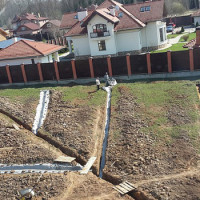 Do-it-yourself site drainage: features of the construction of various types of drainage
Do-it-yourself site drainage: features of the construction of various types of drainage 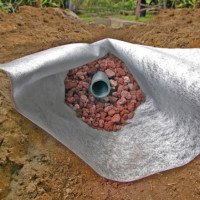 DIY drain pipe installation: step-by-step instruction + analysis of nuances
DIY drain pipe installation: step-by-step instruction + analysis of nuances 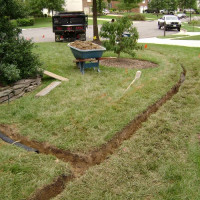 How to make garden drainage with your own hands: analysis of arrangement technology
How to make garden drainage with your own hands: analysis of arrangement technology  Drainage scheme around the house: the nuances of designing drainage systems
Drainage scheme around the house: the nuances of designing drainage systems  How much does it cost to connect gas to a private house: the price of organizing gas supply
How much does it cost to connect gas to a private house: the price of organizing gas supply  The best washing machines with dryer: model rating and customer tips
The best washing machines with dryer: model rating and customer tips  What is the color temperature of light and the nuances of choosing the temperature of the lamps to suit your needs
What is the color temperature of light and the nuances of choosing the temperature of the lamps to suit your needs  Replacement of a geyser in an apartment: replacement paperwork + basic norms and requirements
Replacement of a geyser in an apartment: replacement paperwork + basic norms and requirements
A drainage system is the first thing to take care of. Yes, troublesome, but the result is worth it. We have the whole village drowning in the mud, when the snow melts or a good rain passes. There used to be norms, but now everything is on the conscience of the people themselves. I've taken care, made drains and grooves on and around the site. Everything is neat and clean with me. And the lawn does not wash, and there is no dirt. I want to organize a pond now.
The drainage device on the site is a very useful thing, especially when snow and ice begin to leave in the spring. In our Leningrad Region, with errors in the design and installation of such systems, it is quite possible to get a swamp instead of your favorite personal plot. There is a question that arose in the practice of designing drainage. The article indicates that surface runoff can be diverted to a special system or to a water body.
We do not have a special drainage system for the village, and many solve the problem by sending the “sleeve” to the river. I talked with a lawyer colleague and he explained that such a sleeve violates the law, saying that the Water Code requires in this situation to receive a decision on the provision of a water body for use. In general, it’s strange (I pour this into a river there - it flows much more from the banks), but I don’t want to get into a bad situation. Maybe there is some technical solution to this problem? (some kind of home-made filter or something else). Thank!